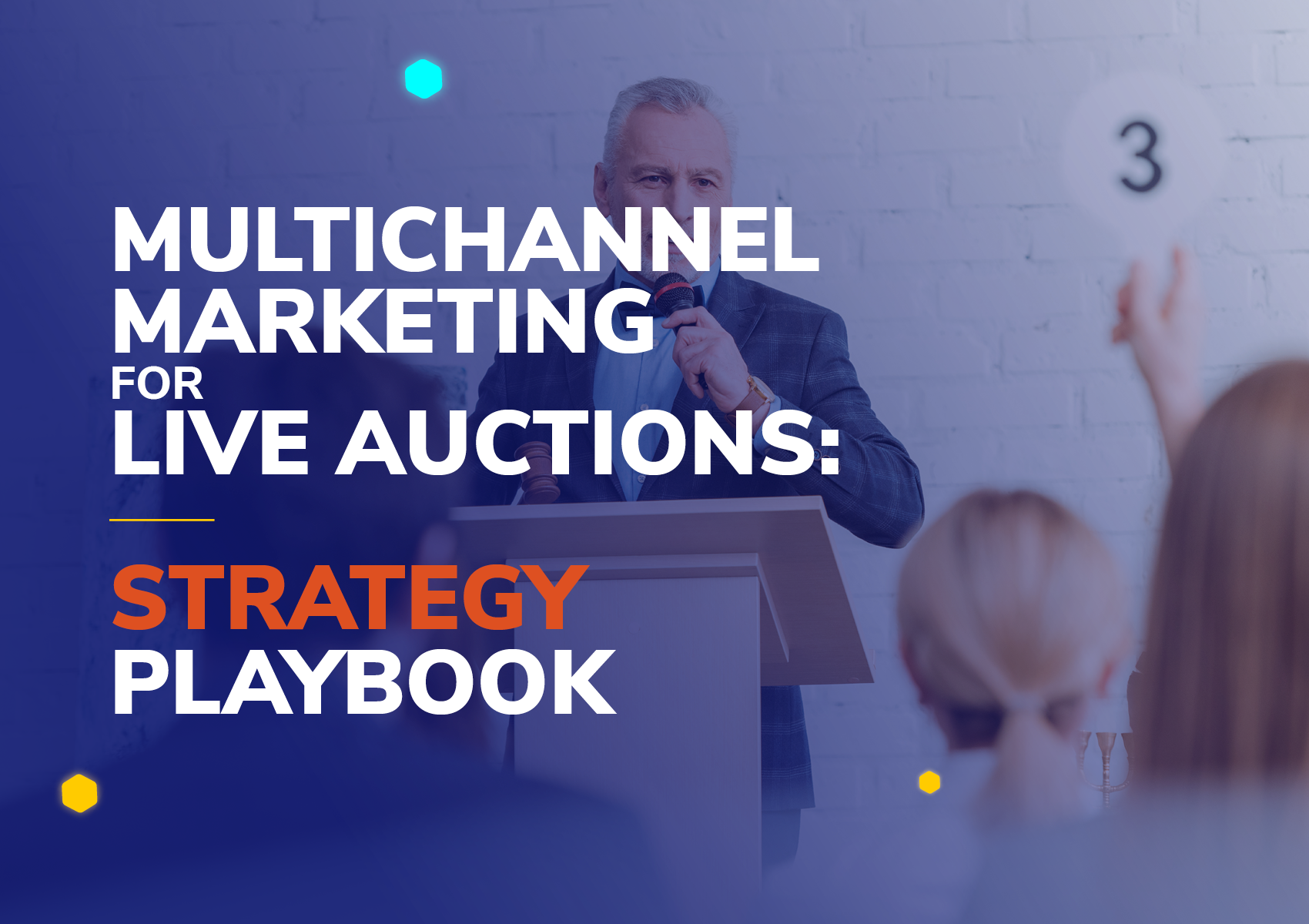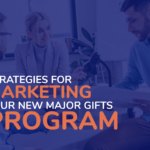Multichannel Marketing for Live Auctions: Strategy Playbook

Live auctions create amazing opportunities for nonprofits, generating revenue, engagement, and fun memories for everyone involved. They can be tricky to plan, but when done well, live auction fundraisers pay off!
But, like with any event, auctions need effective promotion to succeed.
Results hinge on attendance, especially for live formats that are less likely to take place virtually and are targeted to smaller audiences than most silent auctions. Live auctions are also often paired with galas—if you’re planning an annual gala with a live auction, you’ll be trying to reach an even smaller subset of high-impact donors. Getting the word out is essential for success!
Today, multichannel is the watchword for marketing success. Let’s take a look at a multichannel marketing framework you can use to promote your next live auction (and adapt for all kinds of future events).
1. Determine key guidelines for your live auction.
Start by outlining some essentials for your event that will shape how you market it. These include:
- Its context. Will your auction be held as a standalone event or as part of a gala? Will it occur in conjunction with another fundraising campaign, such as your year-end giving push?
- Its goals. How will you measure and determine success? Consider your objectives for attendance, revenue, average bid amounts, and other engagement metrics.
- Its audience. Define the donor personas you’re targeting based on the context and goals—for instance, do you want to attract major donors located nearby? Or a broader segment of mid-level and major donors with track records of attending events?
- Its timeframe. How long do you have to promote your auction before the big day?
Each of these guidelines will impact your marketing approach, so taking the time to carefully define them upfront helps immensely and will result in a more effective strategy.
2. Take a closer look at your auction’s audience.
After loosely defining personas for your target audience, try to learn more. The most effective nonprofit marketing is personalized, targeted to a specific audience’s motivations and interests.
To do this, review your CRM to analyze the performance of past events, ideally past auctions. Who did you invite? What donor segments did they fall into? How did you promote the event and through which channels? Did the events reach their goals? If you sent post-event surveys to attendees, review that data as well.
From this information and your goals for your current auction, make a few inferences about your target audience’s:
- Target spending levels
- Interests based on demographics, current trends, and anecdotal data
- Preferred marketing channels
This process should give you a clearer view of your target audience for the auction and reveal helpful insights about the angles and elements that will best catch their attention.
3. Compile a case statement and brand assets for the event.
Now it’s time to get more tactical. Draft the key messages that you’ll reinforce throughout your auction’s promotional materials—its context, intended impact, why supporters should attend, the exciting items they can win, and more. A short document of key facts and impactful messaging will serve as a useful reference for your whole team once the marketing process is underway.
Next, gather other assets, including:
- Versions of your organization’s logo that you want to use for the event
- Logos of any event sponsors
- Photos from your last auction
- Success metrics and attendee testimonials from your last auction
- Any secured items from your auction catalog that you want to tease (even if item procurement is still in process)
- Ticketing and venue information, as well as other details like how the event will work
Compile all these materials into an event brand book that will serve as a reference for your whole event team. Let them know that it exists, and save it in an easily accessible place.
4. Create a central auction microsite.
You’ll need a central digital hub to anchor your live auction marketing strategy. Many nonprofits opt to create a microsite for their large-scale events like galas, although a dedicated web page will work well for smaller-scale events.
This approach works because it simplifies the marketing process and streamlines the user experience. All of your auction’s marketing messages will point back to here as the place to convert, i.e. register to attend the auction.
When designing a microsite, be sure to follow a few best practices. Use an engaging mix of visuals, but don’t overcrowd the design to keep it accessible and appealing. Make sure that your microsite includes an intuitive navigation function split out into the key things that prospective attendees will want to know, including:
- Event details
- Item catalog (Winspire’s easy item catalog template can help!)
- What the event will accomplish
- Additional information about your nonprofit
- How to register
Include an embedded registration form directly on the front page of the microsite, and take steps to ensure it collects information correctly (ideally through direct integration with your CRM or with easy data export functions).
5. Lay out your additional marketing channels.
In addition to the central microsite or web page, determine how else you’ll reach your target audience of auction attendees. Consider your audience’s preferred channels. Where have you most effectively reached them in the past?
For a live auction targeting a relatively small group of high-impact donors, you’ll likely use a mix of channels like these:
- Email, the quickest and most direct way to get the word out
- Direct mail invites to make a positive, tangible impression on attendees
- Personal outreach via phone calls from gift officers to check in and answer questions
- Social media to give the event a steady but unobtrusive online presence
Be mindful not to overextend yourself—a small handful of targeted channels, each serving a clear purpose in the strategy, will be much more effective and easier to manage than a wide variety that scatters your energy and resources.
6. Develop messaging plans and materials.
Now it’s time to bring your marketing campaign to life!
When creating marketing content, it’s helpful to consider the full journey of your message. That is, you need to introduce the event, engage the audience with interesting material that builds their attention, and then make the ask (registering to attend).
Here’s how you might accomplish these objectives using the channels listed above:
- Create an email stream to send your targeted audience segment. Use it to send an initial save the date-style invite, auction item teasers, messages about how excited you are for the event’s impact, an initial registration ask, and follow-up reminders. Each of these messages should link straight to the event microsite where readers can learn more or go ahead and register if they’re ready.
- Your direct mail efforts should be smaller in scope due to cost, so segmentation is especially key. Focus on those prospects who are most likely to engage with direct mail or who haven’t responded to digital content in the past. On your invitations, include contact info and a URL or QR code for your event microsite to bridge the gap between print and digital engagement.
- With personal outreach, compile talking points for personalized chats about the event to deploy if prospects don’t open your emails or register after a certain point. Provide gift officers with clear instructions for logging new registrations as they’re secured.
- Use your social media posts for ongoing engagement boosts. Create a variety of interesting content, including photos of your highest-value live auction items, media from past events, and impact statistics. Just be mindful of your audience on this channel if you’re taking a very targeted attendance approach.
By understanding the role that each channel plays and what kind of content your target audience is interested in, you can flesh out a full marketing journey that actively guides readers toward registering for the event (and getting excited for the big day).
7. Track your auction’s marketing results.
To measure the effectiveness of your marketing campaign, you’ll need to collect data as it unfolds.
The baseline metric to track will be completed registrations. This is the central objective of the campaign, so take the time to ensure that you can 1) easily collect this data through data integrations or exports, as mentioned above, and 2) associate incoming registrations to individuals within your CRM.
Additionally, you’ll want to keep tabs on clickthrough rates to your event microsite or web page and its incoming traffic by source. This will show you which channels most effectively funnel readers to the central place to convert—very helpful information for future marketing campaigns.
Channel-specific metrics like email open rates and social media impressions give you an even closer look at the impact of your marketing strategies and help you fine-tune your approach over time. If time permits, these metrics can point you to quick real-time improvements. If open rates are very low, for instance, take a moment to refine your email segments and test different subject lines for your next message.
Regardless of the timeframe of your marketing campaign, identifying what performance data you want to track and setting up the necessary processes are very important steps to take, both for your current auction and your next events.
8. Consider the rest of the registrant experience.
Once your marketing strategy is deployed and you begin securing registrations for your auction, your job isn’t done yet.
Prioritizing the post-registration experience will help ensure that your attendees stay excited for your auction and come prepared to actively engage and bid on your items. Think of it as proactive donor stewardship that will improve their experience before, during, and after the event.
Once a prospect registers, have a plan to stay in touch—beyond simply sending a confirmation and a reminder a few days before the event. Taking some simple extra steps will go a long way to show supporters that you value their involvement.
This process can be simpler than the initial marketing campaign. Just create a separate email stream for registrants that covers:
- Confirmation of registration
- Additional information about the event and its goals
- How the auction will work (for instance, if there are any pre-bidding options)
- Catalog previews
- Logistical details like parking, food preferences, etc.
- A reminder a few days before the event
This range of content will keep your auction on attendees’ minds and potentially save your team time on ad hoc follow-up and logistical questions when they’re already busy prepping for the event itself.
Finally, when the event is over and you’ve expressed your gratitude, make sure you have a plan to collect feedback. Direct input from attendees is among the most valuable information you can gather to drive engagement with future events. Pre-draft a quick survey to make this process easy after the event.
Even if you’re not a full-time digital marketer, multichannel event marketing success is much less of a mystery than you might assume!
For a live auction, the keys to an effective strategy will revolve around understanding your audience, determining the right channels to use, and building out an engaging marketing journey that builds up to your registration goals. Support this process with organized processes and quality content, and you’re off to the races. Best of luck!


